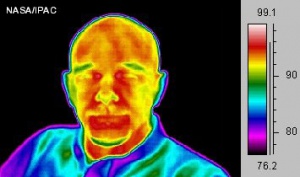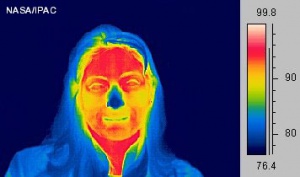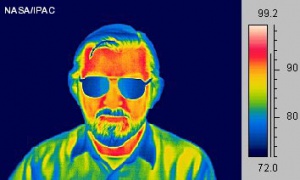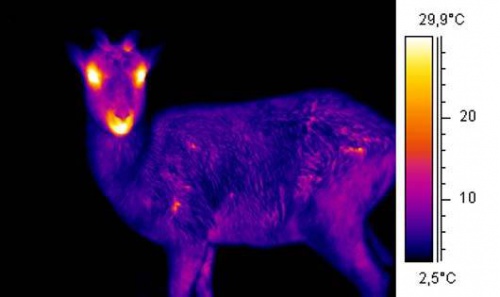Calorimetry Lab
Welcome to the Calorimetry Gen Chem Lab...sort of...
As was discussed in lecture this morning, the current chapter is titled thermochemistry...the heat associated with a chemical reaction. You now have a clear understanding of a chemical reactions...there are reactants, products, balancing coefficients, and now there is heat. Let's start our conversation with a simple observation.
Thermal Imaging
 |
 |

|
All living organisms have many chemical reactions going on 24/7. Most of these reactions are exothermic, meaning that these reactions give off heat. So you should not be surprised to see that a person, like the man on the left is radiating heat. As you know, humans are warm blooded organisms that maintain their body temperature at 37 oC or 98.6 oF. The above images use infrared (IR) imaging to detect the heat (IR light) emitting from all warm blooded organisms. We will talk more about IR light in our next chapter.
The man on the left has a skin temperature of ~93 oF (yellow/orange). The inside corners of his eyes and his lips are slightly higher in temperature at ~95 oF (red). since the outside/room temperature is usually less than body temperature, the surface of the skin is slightly cooler than the internal core temperature of 98.6 oF. This is why when we measure the temperature of an individual, it is best to put a thermometer under your tongue or in up the ... (you know). There are devices that are calibrated to measure internal temperature by measuring outside skin temperature, but these are not as reliable as doing an "under tongue" measurement.
The woman above and in the middle has an IR image that i slightly different from the man.
- Q: What differences do you see? (write these down in your notes...then move on).
The first thing i noticed with the IR image of the woman is that her neck and forehead were warmer than the man, also her nose is quite cold. It could be the case that she just came in from the cold outside; she might have worn a scarf with her nose unprotected from the cold. Additional , she might have a fever. Additionally, notice how her hair and clothing are much cooler, much closer to room temperature.
The man on the right has glasses and a beard that maintain a temperature cooler than the body temp or closer to room temp. Hair in general insulates the body from heat loss.
I could share all kinds of stories about IR imaging. Our department has multiple iphone/android IR camera that we use in Chem 312 (Thermodynamics). But i will stop after these two images:
 |

|
The thermal image of the deer (left) shows how well its fur insulates it from the cold. The thermal image on the right shows how this type of imaging can be used to identify hidden items under clothing.
Here is a fun article about thermal imaging of animals (optional): Hot and Wild 14 Thermal Images of Animals
Chemical reactions
In the following (awesome) video, you will see the thermal imaging of 5 chemical reactions:
- 1) NaOH (s) --> NaOH (aq)
- Dissolving a piece of solid sodium hydroxide into water. This process/reaction with water is called dissolution or just dissolving.
- 2) H2SO4 (l) --> H2SO4 (aq)
- Concentrated sulfuric acid is ~98% pure. This process/reaction with water is also a dissolution or dissolving sulfuric acid into water.
- 3) H2SO4 (l) + cellulose --> carbon (s) + H2O (l) and more.
- In this reaction H2SO4 (l) is reacting with cellulose (carbon/hydrogen, ie sugars); this results in the dehydration (loss of water) of cellulose.
- 4) HCl (aq) + NaOH (aq) --> H2O (l) + NaCl (aq)
- This is a acid-base neutralization reaction.
- 5) Na(s) + H2O (l) --> NaOH (aq) + H2 (g)
Envisioning Chemistry: Getting Hot (with Thermal Imaging)
Units of Heat
The honorary unit of heat is named after the scientist James Prescott Joule. A joule is abbreviated J and is defined in terms of other units as:
The following fun facts comes from the Wikipedia page on the unit, joule
Of the above fun facts, the one that is most important to chemist is the heat required to raise the temperature of 1 g of water by 0.24 °C. Why you ask...well, in the examples shown in the video above, we saw the water heat up when a chemical reaction occurred. Take for instance the addition of solid sodium hydroxide to water.
- NaOH (s) --> NaOH (aq)
How much heat (in joules) was generated during this reaction? If you do an internet search on the "heat of dissolution" or "heat of solution" [your book has some of these, but not NaOH (s)] you will find a tabulated value of -44.51 kJ/mol, which is referred to as the "enthalpy of solution" or enthalpy of dissolution or "heat of solution" abbreviated (ΔH). Let's look more closely:
- - this value is negative, meaning that the process is exothermic (heat is given off by NaOH when dissolved in water, the heat goes into the water).
- - the value is is kJ (kilojoules) not J (joules).
So this means that if you took an entire mole (~40 grams) of NaOH (s) and dissolve it in water, you would get 44,510 J or 44.51 kJ of heat given off by the NaOH (s) with this amount of heat going into the water. Now back up to the fun facts...1 J will raise the temperature of 1 gram of water by 0.24 oC.
Example 1
- Q: If 1 mole (~40 g) of NaOH is dissolved in 1000 mL (1 L) of water, what is the change in the temperature of the water?
- A: To answer this question we must introduce the concept of "heat capacity." As stated above, 1 J will raise the temperature of 1 gram of water by 0.24 oC. Heat capacity is in units of J/(goC), so the above statement says: 1J/(1 g * 0.24 oC) = 4.16 J/(goC); the currently accepted value for the heat capacity of water is 4.184 J/(goC). So using the following equation (e. 6.12 - Chang/Goldsby):
- q (heat in J) = (mass of water in grams) * (Specific heat of water) * (ΔT in units of oC - change in the temperature in oC)
- 44,510 J = 1000 g * 4.184 J/(goC) * ΔT, solving for ΔT = 10.6 oC.
The following problems will be worked out on paper and emailed to Brad before Easter Break.
Problem 1
- Q: If 1.00 mole of NaOH is dissolved in 500 mL (500 g since the density - 1g/ml) of water, what is the change in the temperature of the water?
Problem 2
- Q: If 0.50 mole of NaOH is dissolved in 500 mL of water, what is the change in the temperature of the water?
Problem 3
Note: to do "Problem 2", you needed to figure out how many J 0.50 moles of NaOH (s) would produce. You might have done something like this:
- 1 mole/44510 J = 0.5 moles/X J --> solving for X = 0.5 moles * 44510 J/ 1 mole = 22255 J. The value 44510 J/mol is called the enthalpy with the symbol ΔH. Look closely at the units, if you multiple the enthalpy by the number of moles you get J.
- Q: If 0.321 mole of NaOH is dissolved in 500 mL of water, what is the change in the temperature of the water?
Problem 4
Note: in order to do this problem, you need to convert grams to moles first, then repeat as above...
- Q: If 12.3 gram of NaOH is dissolved in 500 mL of water, what is the change in the temperature of the water?
Review
- - Chemical reactions or processes that generate (or absorb) heat have an enthalpy value (ΔH), ex. enthalpy of dissolution with the units of J/mol.
- - Water has a specific heat of 4.184 J/(goC), which is an indicator of how water will change temperature as a result of added heat.
- - MANY reactions/processes take place in water, so the key equation to use in many questions is,
- q (heat in J) = (mass of water in grams) * (Specific heat of water) * (ΔT in units of oC)
- - Keep your eye on units...
- - ΔH (J/moles) * # moles = J
Remember, email me Problems 1-4 by Thurs 5 pm.

